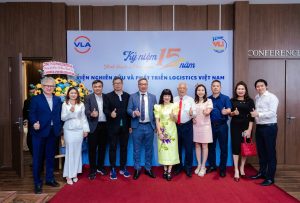Transportation, warehousing, logistics: Overcoming limitations, reaching expectations
vlimonamedia
15/07/2024
Transportation, warehousing and logistics are not only the bridge between production and product consumption, between residents and travel needs, but also the driving force of social growth and development…

Transportation, warehousing and logistics are the bridge between production and product consumption. At the input, with a total GDP of about 430 billion USD in 2023, accounting for about 50% of the total production value, that is, intermediate costs account for about 50% of the total production value. Plus the cost of fixed assets of about 5%, that is, about 55% of the total production value, equivalent to about 450 billion USD. That means the input material cost is currently about 450 billion USD. That is a very large scale. This scale depends on the import of both goods and services of about 300 billion USD (about 150 billion USD domestically).
In terms of output, the scale of consumer goods, only counting the two real economic sectors (including agriculture, forestry and fishery, industry and construction, excluding output), the scale is also up to over 200 billion USD. The total input and output scale is up to 680 billion USD, which is a very large scale, creating a huge demand for the transportation and warehousing industry. In 2023, the volume of transported goods reached over 2.34 billion tons and the turnover reached nearly 4.4 billion tons/km, which is not a small scale. If the scale of production, consumption and import increases further, the demand for the transportation and warehousing industry will also be very large. If the turnover structure changes, the turnover volume will be even higher.
POSITIVE RESULTS
Transport is the bridge between the population and the travel of Vietnam is not small: in 2019, the number of passengers transported reached 4.78 billion and the turnover reached 206.7 billion passengers/km. If that demand increases again, the passenger turnover structure shifts, the number of passengers/km will be even higher, creating an even greater demand for transportation and turnover.
Logistics is a comprehensive activity, in addition to the transportation and warehousing industry, it also belongs to other economic sectors. It is an industry whose foundation is integration, with connections to many industries, forming a “matrix”, thus creating professionalism and “double” efficiency, that is, increasing the efficiency of other economic sectors.

The added value of the transportation, warehousing and logistics industry accounts for 4.92% of the country’s GDP (2023). If added with the added value in other industries, the total added value of the transportation, warehousing and logistics industry accounts for an even higher proportion and ranks about 5/20 of the secondary economic sectors. Therefore, the added value of the entire transportation, warehousing and logistics industry will account for a higher proportion and contribute to increasing the scale and growth rate of the country’s GDP. Therefore, transportation, warehousing and logistics are considered the driving force for economic growth and social development.
Transportation, warehousing and logistics have achieved positive results in many aspects.
Regarding transportation and warehousing infrastructure, an important change is the change in position. Previously, it was the position of “people needing vehicles”; for several decades now, it has changed to the position of “vehicles needing people”.
Means of transport have changed from depending on public vehicles (state-owned vehicles) to private vehicles (including private vehicles, private cars); from “the intensity of bicycle-pedal power” to the intensity of motorbikes and cars of all kinds. The road system has changed significantly: from airports, sea routes, highways, national highways, provincial roads, district roads; many communal, village and hamlet roads have been built, expanded and upgraded through the new rural construction program, contributing significantly to changing the face of the countryside. The system of airports, seaports, bus stations and large bridges has been built, expanded and upgraded in quality.
Warehouse systems and logistics centers are developing. Expectations are for the North-South expressway, the North-South high-speed railway, the subway, the elevated railway, elevated parking lots, ocean liners reaching out to sea, transporting goods around the world. The number of newly established transportation and warehousing enterprises is increasing; the number in operation by the end of 2023 is high, ranking 4th among 20 secondary industries,…
Passenger transport and turnover have achieved many positive results. Number of passengers transported from 2015 to present (Figure 1).
Number of passengers transported has continuously increased from 2015 to 2019; only decreased sharply in the 2 years of the pandemic
Covid-19; in 2022 it increased again (59.7%); in 2023 it increased and reached a higher level than in 2018 and earlier, only lower than the record level reached in 2019. The growth rate is important, but it also depends on population growth, so for comparison, it is necessary to calculate the average number of trips per person per year.
On average, per person per year traveled by other means (excluding personal vehicles), if in 2015 it reached 35.9 trips, then in 2019 it reached 49.5 trips, 1.4 times higher than in 2015. By 2021 (when the pandemic broke out), it decreased to only 25.6 trips, only over half of 2019; But by 2022 it had increased again, reaching 40.5 times and in 2023 it is estimated to reach 46.7 times, almost equal to the record level of 2019.
The number of passengers transported must also be analyzed according to the structure of the transport industry, because the scale and growth rate depend on the length/shortness, fast/slowness and convenience of people’s travel (Figure 2).
The number of passengers by road accounts for the largest proportion, but tends to decrease gradually because some people travel by private car or choose faster, longer means of transport… The proportion of waterways has remained almost unchanged. By 2019, the proportion of railways is half that of 2015. Air transport has an increasing proportion thanks to fast, long-distance travel, but in 2023 it will decrease due to high prices.
If calculated by the number of passenger turnovers, the results are as follows (Figure 3).
The number of passenger turnovers in 2019 was the highest; but decreased by 34.5% in 2020 and decreased by 27.9% in 2021 due to the impact of the pandemic. In 2022, there was a fairly high increase (95.7%) due to the shift in pandemic prevention and control and partly due to the low base of comparison in 2021. In 2023, the recovery momentum was quite high and exceeded the record in 2019. If we look at the structure of passenger turnovers by transport sector, it is different from the structure of passenger turnovers (Figure 4).
The difference compared to the passenger transport structure due to the long-distance road transport of an average passenger of the transport sectors (2023) is quite different. Specifically: railway 361.6; road 36.3; waterway 36.2; air 1,449.1; waterway, road is almost equal and equal to 1/10 of railway, equal to 2.5% of air; rail is equal to 25% of air.
Adding the average travel distance of a passenger, if in 2015 it was 46.7 km, then in 2019 it reached 48.3 km, higher than previous years, but in 2020 it was only 27.1 km, in 2021 it was only 37.2 km, in 2022 it reached 44.9 km, higher than the level of the years from 2018 and earlier. In 2023, it is estimated to reach 52.8 km, higher than the record achieved in 2019.
Freight transport and circulation achieved many positive results. The volume of transported goods has increased continuously for several years, from 2015 (233,429.2 million tons) and reached a record in 2019 (297,238.7 million tons); decreased during the 2 years of the pandemic but decreased slightly compared to passenger circulation. In 2023, freight transport and circulation recovered and reached a new record of the largest ever (489,670 million tons).
The volume of transported goods increased continuously from 2012 to 2019 (reaching 297,238.7 million tons.km), then decreased during the 2 years of the pandemic; in 2023 it increased again, estimated at 489,670 million tons.km.
The average number of kilometers transported per ton of goods, if in 2015 it was 202.7 km, in 2019 it reached 177.9 km, in 2020 it was 176.6 km, in 2021 it was 111.6 km, in 2022 it was 188.5 km, in 2023 it was estimated to reach 208.9 km.
The structure of goods transported by transport sector (Figure 5) is different from the structure of goods circulated by transport sector (Figure 6) due to the different transport lengths of different transport sectors.
Logistics has received special attention in recent years. In 2017, the Prime Minister issued Decision No. 200/QD-TTg, in 2021 there was Decision No. 221/QD-TTg amending Decision No. 200/QD-TTg. Logistics is not a separate service industry but is part of many industries integrated from many industries, the largest of which are transportation, warehousing and transportation support…
VNECONOMY
Tag





